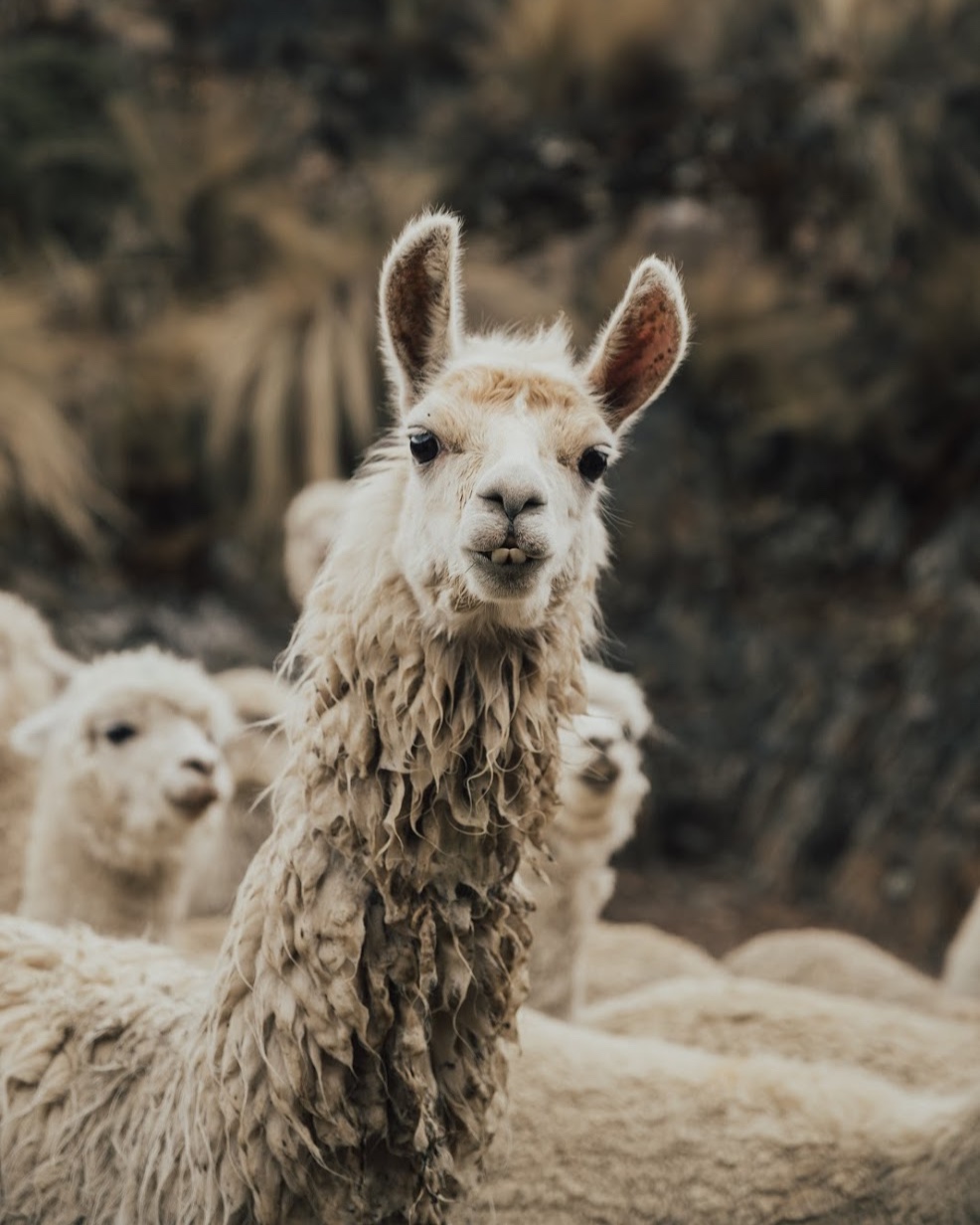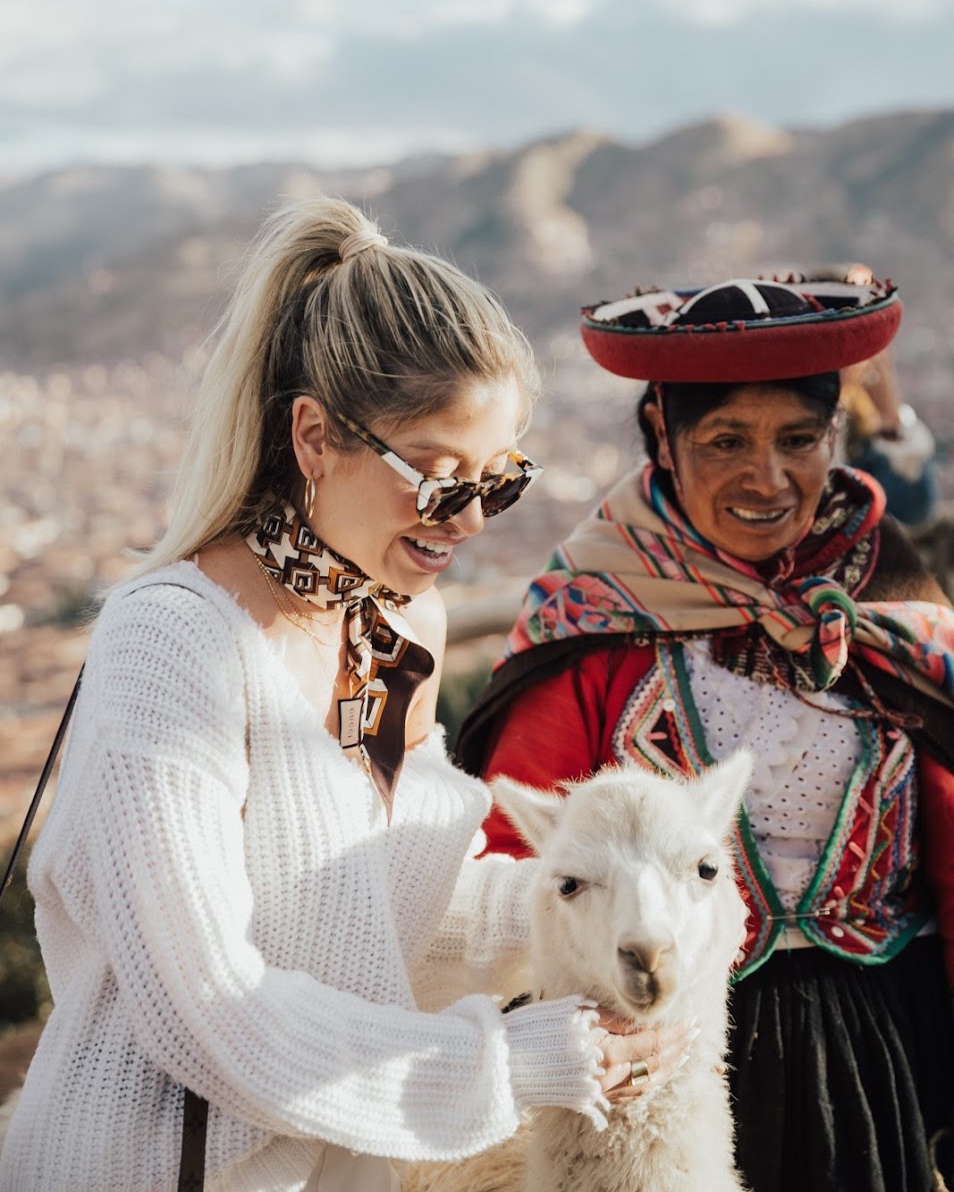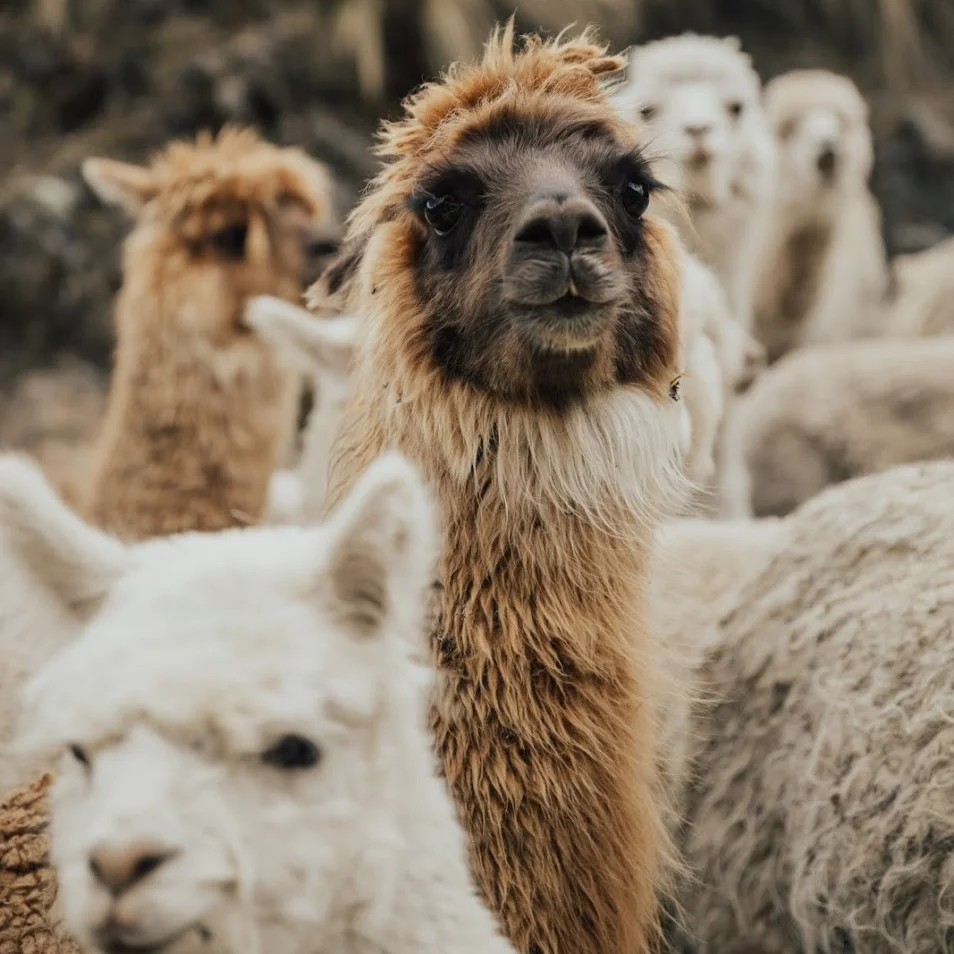
Who doesn’t love a llama? These curly haired cuties are full of surprises and have become synonymous with Peru. The high altitude of the Andes mountains has made the llamas and alpacas (yes, there is a difference) vital to Peruvians’ way of life. Here are a few things that might surprise even you, you llama super-fan.
Llamas have oval shaped blood cells.
Most llamas live between 24,000 and 42,000 feet in elevation. In contrast, Denver, Colorado, the Mile High City, is just 5,280 feet above sea level. That’s a huge difference, and it’s no surprise that when you land in Peru it is recommended travelers take a couple of days to get used to the elevation differences. Llamas are particularly well adapted to the harsh climates and rugged terrain they live in. In order to store more oxygen in their bodies, Llama blood cells have taken on an ovular shape in order to hold more oxygen at higher elevations where there is less to be found. These elongated blood cells also help to protect llamas from dehydration!
Llamas need a pack.
Llamas are super clique-y! They have a pecking order for every llama in the pack. In an ideal setting, six llamas make up a pack with each llama knowing where it falls in the ranking of one through six. The head llama is very aware that it is his responsibility to protect the pack and keep everyone in line. Often the second in command will challenge the leader. Challenges are one on one battles for dominance with the llamas charging at each other and locking their necks together. The victor is the one who doesn’t back down from the other spitting in its face. If there are more than six llamas around, then llamas group together and fight other packs for the best land and food.
While a llama can never be a solo animal, they don’t necessarily need other llamas around in order to be happy. A llama can be perfectly content ruling as the head of the heard of goats or sheep. Since the llama’s instincts kick in to take care of the pack much like other head llamas, the lone llama gets the best of both worlds - being in charge and never having his authority challenged.
Llamas don’t spit (at people).
Really??? Really! Llamas don’t really consider people as animals to assert their authority over. We are kind of like birds to them - interesting to look at and listen to, but of no real consequence at all. Llamas only spit at each other as a warning that a lower ranked llama is encroaching on something of theirs or to challenge another llama for their ranking in the pack. So you’re safe. Really. Give that llama a kiss!
Never kiss an alpaca though. They will spit on you faster that you can say alpaca us a picnic.Llamas talk with their ears.
They also hum and wiggle their tails to talk to each other. Hums typically are a sign of displeasure with another llama, person or creature. There is still much to be understood about how llamas communicate with each other, but their ears are in near constant movement reflecting seemingly reflecting what is happening around them and in relation to each other.

5. Llamas have really short tongues.
If you’re traveling to Peru, then you know you’re about to see some llamas up close! One thing to keep in mind when going in for a spit-free pet is that llamas have short tongues. What do tongues have to do with petting a llama anyway? Because of their short tongues, baby llamas never have the experience of being licked clean by their mother, so the petting sensation your dog loves on their belly is quite foreign and surprising to a llama. Chances are, they won’t tolerate it and wander away from you. For most fluff for your pet, try petting the llama under his chin, on his head or around his neck.
Want to know more about llamas? Check out our story on Llama Blessings!
📍Peru
7 to 10 days from $3,800
Limited to 16 travelers
See Details >
50% off with code: “50OFF”
For select travel dates until December 2025
Offer expires March 31st, 2025
The Amazon is famous for its biodiversity, curious wildlife, and impenetrable jungles. But, when you think of the Amazon Rainforest, you probably think of Brazil. What a lot of people don’t know is that portions of the Amazon are also in Northern Peru, and even extends into parts of Colombia! The Peruvian Amazon is waiting to be explored, so here is why you NEED to go there!
The Peruvian Amazon is home to some of the most interesting animals on the planet. Here are five you can encounter on your Andean adventure.
Virtual tours are an interactive experience and thanks to the internet, we can basically go anywhere in the world! They are hosted on a video conference platform, like Zoom, and allow people to sign on and experience it in the comfort of their home. We are so excited to announce the launch of FREE (donation based) virtual tours to support locals around the world while bringing adventure to your home!
One of the newly added Wonders of the World, Machu Picchu is an Incan citadel set amongst the Andes Mountains in Peru. It has quickly become a bucket list-worthy spot to visit, but when is the best time to go? The answer is here! Keep reading to know the best time for you to visit Machu Picchu!
Rated as one of our top 20 destinations to visit in 2020, a trip to Peru is truly incomplete without a visit to the former capital of the Incan empire and UNESCO heritage site, Cusco. Situated in the Peruvian Andes at an elevation of 3,400 meters, Cusco is vibrant in its colonial historic architecture, incredible local cuisine, cobblestone streets and markets abundant in textiles of every color. Cusco serves more than a gateway to Machu Picchu and here's why you might want to spend a few extra days in this city, with our list of things to do in Cusco.
Are you thinking about traveling to Peru? Already have your trip booked and you’re stressed with what to know before you leave? Being a large, beautiful, unique country, it can be overwhelming with all that there is to know in preparation for your trip. Here are 10 things to know before traveling to Peru!
Trying to plan a family getaway but not sure where to start? We know it can be difficult to travel with the whole family. After all, how do you find a destination that is appealing to both adults and kids of various ages? Luckily, we have done the work for you! Read below to discover five of the top family-friendly destinations in the world.
Seattle resident Nikki Rymer had always wanted to visit Machu Picchu — and thanks to Acanela, she finally got her long-awaited chance to travel to Peru. It was a dream come true, and after she returned home, we loved hearing a little more about her experience. Here’s everything that she told us about her trip.
Best friends Anna and Jillian have always loved traveling with each other. When they found out that Acanela was offering a two-for-one discount on its classic Peru expedition, they jumped at the chance to visit South America together. After their trip ended, Anna told us a little more about traveling to Peru with her best friend.
Henry Thompson and his family had no idea how much they would love Peru. But between the hikes, market visit, cooking class, and llama blessing ceremony that they experienced, this family vacation was a dream come true. Here’s what Henry had to say about the trip.
Summertime often evokes images of frosty glasses full of ice-cold lemonade, scrumptious ice cream cones, and lazy days on a sandy beach with a great novel in hand. For most people, the lengthening days bring with them a much-anticipated break from school or a slower work schedule. It is no wonder that this season has become readily associated with vacation time! The lingering twilight, warm sunshine, and slower pace of life make the summer one of the best times of the year to adventure with those you love. Perhaps you hope to jet off on a romantic getaway to a faraway island, or maybe you want to simply seek respite from the heat in the coolness of the mountains; either way, summer is the perfect time to explore the world. So, whether you are planning to visit the other side of the globe or just the other side of the country, here are some of my top vacation destinations to get you started thinking about your next summertime trip!
Machu Picchu is one of the most popular travel destinations in South America. Here’s everything you need to know to plan a successful trip to this World Wonder!
While there are many things to do and see in the world, some of the most treasured experiences cannot be planned for. Like the time I was invited to a Llama Blessing in the Lares Valley of Peru. The Lares Valley is tucked away behind Machu Picchu and the Sacred Valley, a journey that will take you past tiny mountain villages that dot the mountainside.
Last October, I had the pleasure of visiting Peru for the first time. I was able to interact with the locals, experience their cuisine, and explore the cities. During my stay, one of the most memorable things was the hospitality from the local people and their willingness to open their hearts to travelers. This life changing trip really inspired me to write about the amazing experiences that makes this destination one of my favorites.
The South American country of Peru might be most famously known for Machu Picchu and the Amazon Rainforest, but don’t be fooled into thinking that these are the only things that Peru has to offer. Here are 10 additional sites you may want to seek out during your visit to Peru, and and check out this handy travel guide.
Peru has one of the most diverse climates in the world, making it significantly more tricky to pack for. If you’re planning a trip here, you’ll most likely be exploring sites surrounding Cusco, here is our guide to help you prepare.
Who doesn’t love a llama? These curly haired cuties are full of surprises — here are a few things that might surprise even you, you llama super-fan.
Celebrated as Peru’s most famous hike, the classic Inca trek to Machu Picchu can be considered one of the world’s iconic trekking experiences. In 2007, Machu Picchu was voted one of the new seven wonders of the world.
Peru a is popular designation in South America. This well-known country is home to Machu Picchu, the Inca Trail, and a section of the Amazon River. Peru is the third-largest country in South America! Peru is a well-known travel destination but do you know about their unique hotels?
Peru is a huge country with so much more to offer beyond Machu Picchu, its best-known attraction. Here are some of Peru’s natural wonders that you won’t want to miss on your next visit to this beautiful country.
Peru contains 84 of the 103 ecosystems in the world and 28 of the 32 climates, making it the most ecologically diverse country in the world. And while the country is certainly travel-friendly all year round, the various regions and climates make different times of the year ideal for travel. Read below to figure out the best time to plan your perfect trip to Peru!
With its fresh ingredients and bursting flavors, Peruvian food has been climbing up the popularity charts over the past few years. Some restaurants have even consider the food a “trend.” Be sure to take advantage of all of these delicious dishes during your next trip to Peru!
Many tourists flock to Peru’s most popular wonder, Machu Picchu. This is for good reason, as Machu Picchu is one of the most inspiring and beautiful sites in the world as well as one of the 7 Wonders of the World. However, much of the Northern regions of Peru go unexplored. If travelers only knew the many amazing sites left unseen, I’m sure they would want to add a week or two on to their Peru Expedition.
Imagine taking a 10 hour flight, 3 hour drive, 1 hour train ride , 30 minute public bus, and a a 15 minute hike, you will find yourself at a place voted to be one of the New 7 Wonders of the World--Machu Picchu. While many people visit Machu Picchu, which don't get me wrong - is a spectacular site- they often miss exploring the beauty of the valleys & villages that surround it. Like visiting Juan, his family, and their 1000 alpacas.
Hiking the Inca Trail to Machu Picchu is an experience unlike any other. With three routes to choose from, the trek takes you through the Andes Mountains to the gates of the famous ruins. This journey can be found on many travelers’ bucket lists, and while almost anyone can accomplish it, a lot of important preparation must be done. The expedition will test your physical and mental limits like never before, but the experience and the breathtaking views make it so worth it. Keep reading to learn our tips for hiking the Inca Trail!
A couple weeks ago I went on the most incredible trip with Acanela, and what’s more I was allowed to bring my brother, Cameron, along for free! Together we discovered Peru, learning about their beautiful culture and taking countless photos.
Born and raised in the small village in the Peruvian mountains, Juan has dedicated his life to farming and caring for his family’s home and herds. Because the conditions are so extreme at the top of the Andes mountains, only certain products can survive, namely potatoes, corn, and, of course, Alpacas. This is how they survive in the mountains.
Almeurzo. That mid-afternoon meal where friends and family gather to take time to enjoy one another’s company. It’s not just lunch in Peru. It’s THE meal of the day. Everything comes to a halt for food, and then it’s naptime before heading back to work. Peru celebrates the afternoon like the Europeans celebrates the evening. The magic of a meal, however, is timeless.
Nothing brings people together quite like food. It’s at the heart of so many cultures, and learning about the local cuisine is the perfect way to immerse yourself in a new environment. There are countless destinations across the globe that offer mouthwatering dishes and rich culinary diversity, but some countries reign supreme. Keep reading for the top culinary destinations around the world!
































This year didn’t pan out the way any of us planned to say the least! Most of us had to postpone any travel plans we had. Instead of traveling overseas, we adventured close to home and maybe even got around to a couple of house projects that we were always putting off.